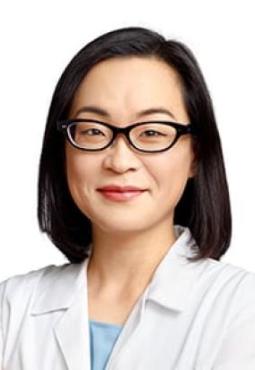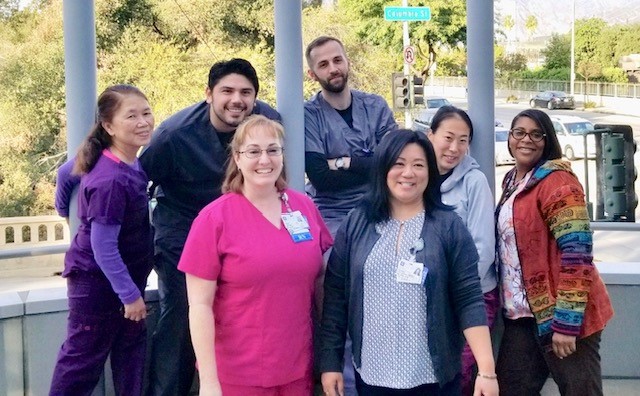An unexpected test result led to some tough decisions for a longtime City of Hope nurse
A direct-to-consumer test gave one City of Hope nurse the key to an unexpected and potentially lifesaving diagnosis.
When Heidi Jakob, 57, a longtime nurse at City of Hope | South Pasadena, took a 23andMe test with her sister, she found the results fascinating. “I learned things like why I’m prone to dislike cilantro and little bits of information like that. It was fun and interesting.”
So interesting that a year later, when her mother decided to take a similar test on Ancestry.com, Jakob agreed to join her — this time electing to see what the limited genetic profiling portion of the test had to say.
When the results came in three months later, Jakob says she knew almost immediately that something seemed different. “My mom got her results almost instantly, but mine wouldn’t open unless I watched a video first,” she recalled. “After watching a genetic counseling video, I could finally see my results. I had tested positive for the BRCA2 gene mutation.”
While not every person who has the BRCA1 or BRCA2 mutation will get cancer, having it puts you at an increased risk for certain cancer types, especially breast and ovarian.
An estimated 5-10% of breast cancer cases today are thought to result from gene mutations passed down from a parent. Based on family medical history, recommended genetic counseling and testing is one way to discover these gene mutations that may increase cancer risk for patients and their relatives.
“At first, I was just confused,” Jakob said. “I had no relatives on my mom’s side with breast cancer. But there was a history of cancer on my dad’s side. I just kept looking at the results and thinking, ‘Well, now what?’”
Showing Her Doctor the Results

Jakob decided to share her Ancestry.com results with medical oncologist and breast cancer specialist Christina Haeyoung Yeon, M.D., at City of Hope | South Pasadena. “Dr. Yeon is the reason I came to work at City of Hope. I’ve always loved the way she works with her patients,” Jakob said. “It’s why I chose her to be my doctor.”
As soon as Yeon, an associate clinical professor in the Department of Medical Oncology & Therapeutics Research and regional director for City of Hope’s San Gabriel Valley practice sites, looked over the test results, she told Jakob to make an appointment with her and ordered follow-up testing. “Two days later, the Center for Precision Medicine contacted me to arrange bloodwork to confirm the test results. Dr. Yeon didn’t waste any time and made things happen quickly.”
After the results came in validating that Jakob was indeed positive for the BRCA2 mutation, she met with Yeon, who was ready with a plan. “She had everything written down and walked me through all my options. It’s one of the things I love about her as a physician.”
“Patients with a genetic mutation that increases their risk of developing future breast cancer, such as BRCA, have several options,” Yeon says. “These include risk-reducing surgery, enhanced breast cancer screening and risk-reduction medications.”
Yeon pointed out that because there is no effective screening test for ovarian cancer. current guidelines recommend removal of both ovaries for patients with BRCA2 if the patient has finished childbearing. If a patient chooses against this option, they face twice a year scans, blood tests and exams.
‘A Personal Choice’
Surgery or surveillance “is a personal choice that the patient must make after discussing all potential options and risks/benefits with their doctor,” Yeon said, explaining that the risk of breast and ovarian cancer varies depending on the exact BRCA mutation a patient has. “In Heidi's case, her risk of developing breast cancer was between 40% and 85%, and 17-27% for ovarian cancer. H
eidi's personality is such that she wanted to be very aggressive with her care, and thus she opted for surgery.”
Jakob elected to have a bilateral mastectomy, as well as removal of her ovaries. Yeon referred her to surgeons Stephen Lee, M.D., a gynecologic oncology surgeon and an assistant clinical professor in the Division of Gynecologic Oncology, and Amy Polverini, M.D., assistant clinical professor in the Division of Breast Surgery, for the procedure. “It was very convenient because I had this phenomenal care team working together, and they were all in the same building. A building I also happened to work in,” Jakob said.

Before surgery, Jakob met with her care team, who explained everything they would be doing and asked if she had any questions. “I love City of Hope because we have access to the latest and greatest, including the doctors who work here. They are all so kind and make you feel like you can trust them,” she said.
From start to finish, Jakob says she felt supported. “One of the things I love about Dr. Lee is that he will look you in the eye, hold your hand and tell you he will take care of you, and he truly does.” In addition, she said, “Dr. Polverini is not only an expert at what she does, but she also takes the extra step to personally check in on her patients before and after surgery, making sure I felt cared for all around.”
Jakob’s surgery, in September 2021, took eight hours. First Lee removed her ovaries, then Polverini removed her breast tissue. Finally, expander implants were placed in her breasts to prepare for reconstruction a couple of months later.
“After Heidi’s surgery, the pathology review thankfully showed no evidence of cancer,” Yeon said.
Going forward, Jakob will be at an increased risk for pancreatic cancer (she will have about a 6.5% chance of developing the disease), according to Yeon, although there is no recommended screening protocol. There is also an increased risk for melanoma, so Jakob has been counseled to avoid sun exposure, wear protective clothing, use sunscreen with a minimum SPF of 30 and have at least an annual skin check performed by a dermatologist.
Going through testing and the bilateral mastectomy and ovary removal also gave Jakob more perspective into what her patients go through every day when they come in for treatment. “Now when patients talk to me about recovery and surgery, I can truly relate to some of what they are going through,” she said. “Cancer happens to the nicest people, and they amaze me with their strength and courage daily. It’s why I love what I do.”
Today Jakob is doing well and is thankful that her mutation was found early. “I went from a high risk of having cancer by the time I was 80 to a less than 3% chance. That test and the care I received at City of Hope probably helped save my life.”